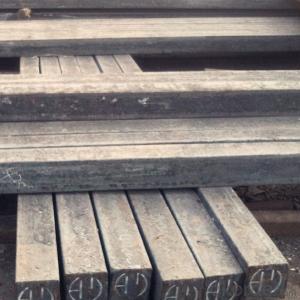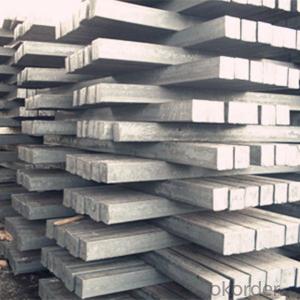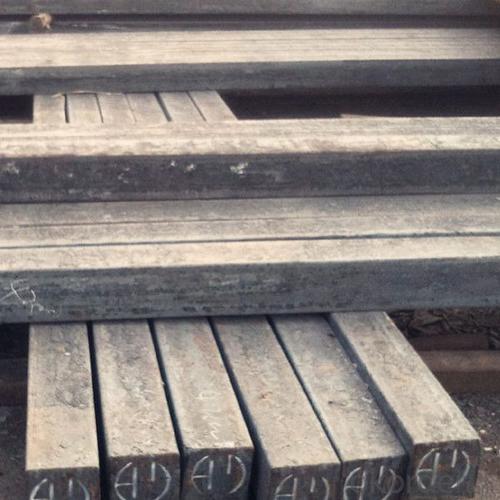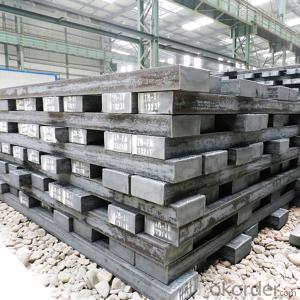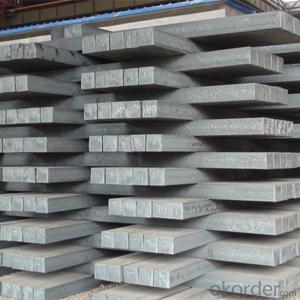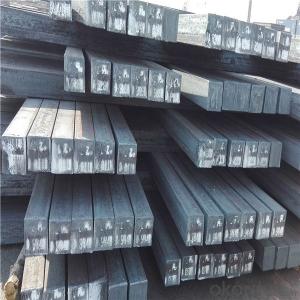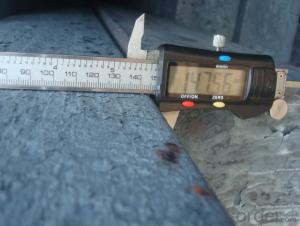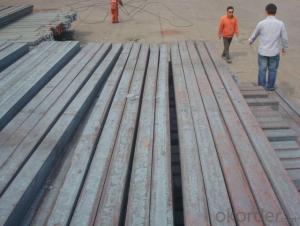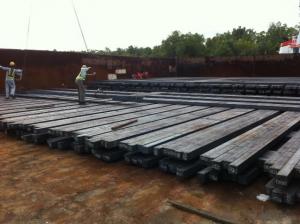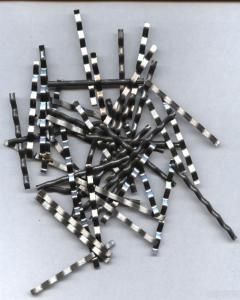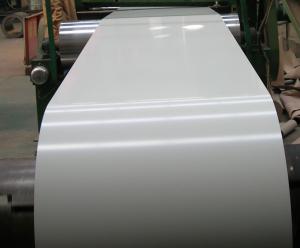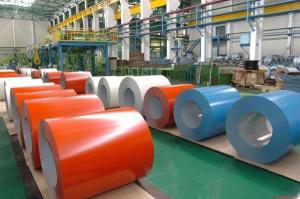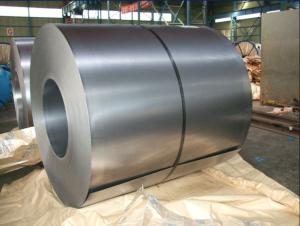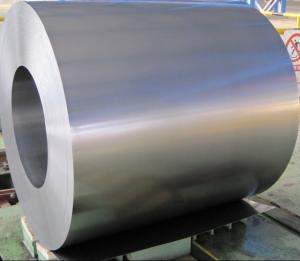100x100mm 130x130mm 150x150mm Prime Square Steel Billet
- Loading Port:
- China main port
- Payment Terms:
- TT OR LC
- Min Order Qty:
- 20 m.t.
- Supply Capability:
- 10000 m.t./month
OKorder Service Pledge
OKorder Financial Service
You Might Also Like
Specification
Prime Square Steel Billet
Size List
| 60x60mm | 80x80mm | 100x100mm |
| 125x125mm | 130x130mm | 150x150mm |
Chemical Comosition
Standard | C(%) | Mn(%) | S(%) | P(%) | Si(%) |
Q195 | ≤0.12 | ≤0.50 | ≤0.040 | ≤0.035 | ≤0.30 |
Q235 | ≤0.20 | ≤1.40 | ≤0.045 | ≤0.045 | ≤0.35 |
Q275 | ≤0.22 | ≤1.50 | ≤0.045 | ≤0.045 | ≤0.35 |
20MnSi | 0.17-0.25 | 1.2-1.6 | ≤ 0.050 | ≤ 0.050 | 0.40-0.80 |
3SP | 0.14-0.22 | 0.40-0.85 | ≤ 0.050 | ≤ 0.040 | 0.05-0.15 |
5SP | 0.28-0.37 | 0.50-1.00 | ≤ 0.050 | ≤ 0.040 | 0.15-0.30 |
| Application |
Angle bar ,Steel Channel,I beam,H beam,Flat bar making.
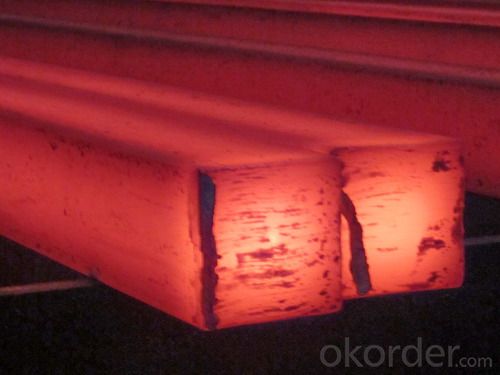

FAQ
Q1: Are you trading or manufacturer?
A1: We are manufacturer with exporting rights;
Q2: How many years have you engaged in this products?
A2: More than 10 years;
Q3: How could you guarantee your quality?
A3: The third inspection can be available,such as: SGS,ISO
Q4: What will you do if buyer ask claim?
A4: We will accept and pay fully to buyer If it's really our responsibility after checking.
Q5: Could you supply samples?
A5: Yes,we can
Q6: What's your payment method?
A6: LC at sight for large quantity,and TT for small orders.
- Q: What are the challenges and innovations in the steel product manufacturing industry?
- The challenges in the steel product manufacturing industry include increasing competition, fluctuating raw material prices, and the need for continuous technological advancements. Additionally, there are challenges related to environmental sustainability and meeting stringent quality standards. In terms of innovations, the industry is witnessing advancements in automation and robotics, enabling improved efficiency and productivity. There is also a focus on developing eco-friendly processes and promoting sustainability through recycling and waste reduction. Furthermore, the adoption of digital technologies such as artificial intelligence and data analytics is driving smart manufacturing and predictive maintenance in the steel product manufacturing industry.
- Q: How is steel used in the production of marine vessels?
- Steel is commonly used in the production of marine vessels due to its high strength, durability, and resistance to corrosion. It is used to construct the hull, decks, and other structural components, providing the necessary strength to withstand the harsh conditions of the marine environment. Steel also enables the vessels to carry heavy cargo and withstand the forces exerted by waves and currents. Additionally, steel can be easily welded and shaped, allowing for efficient construction and customization of marine vessels.
- Q: What are the applications of steel in the wastewater treatment industry?
- Steel has various applications in the wastewater treatment industry. It is commonly used to construct durable and corrosion-resistant tanks, pipes, and other infrastructure for holding and transporting wastewater. Steel also plays a crucial role in the fabrication of screening systems, sedimentation tanks, and clarifiers. Additionally, steel is utilized in the production of specialized equipment such as pumps, valves, and chemical dosing systems, which are vital for efficient wastewater treatment processes.
- Q: How are steel plates heat-treated for improved strength?
- Steel plates are heat-treated for improved strength by subjecting them to a specific heating and cooling process known as quenching and tempering. This involves heating the steel plate to a high temperature and then rapidly cooling it to harden the material. Afterward, the plate is reheated to a lower temperature to temper it, which helps to reduce brittleness and improve its toughness and overall strength.
- Q: How is steel used in the production of construction machinery?
- Steel is commonly used in the production of construction machinery due to its high strength, durability, and resistance to wear and tear. It is utilized in various components, such as the machine's frame, chassis, and structural elements, to provide the necessary strength and stability required for heavy-duty construction tasks. Additionally, steel is often employed in the manufacturing of buckets, blades, and other attachments, as it can withstand the demanding conditions and intense forces typically encountered in construction projects.
- Q: How is steel used in the construction of wastewater treatment plants?
- Steel is extensively used in the construction of wastewater treatment plants due to its durability, strength, and corrosion resistance. It is used for various applications such as structural supports, tanks, pipes, and equipment. The steel structures can withstand the harsh environment and chemicals found in wastewater, ensuring the longevity and reliability of the treatment plant.
- Q: What are the advantages of using steel in shipbuilding?
- There are several advantages to using steel in shipbuilding. Firstly, steel is a strong and durable material, making it ideal for constructing large and heavy vessels that can withstand harsh ocean conditions. Secondly, steel has excellent corrosion resistance, which helps to prolong the lifespan of the ship and reduces maintenance costs. Additionally, steel is readily available and cost-effective, making it a practical choice for shipbuilding. Finally, steel is highly versatile and can be easily shaped and welded, allowing for the construction of complex ship designs and facilitating efficient production processes.
- Q: How is steel used in the production of kitchen utensils and cookware?
- Steel is commonly used in the production of kitchen utensils and cookware due to its durability, heat conductivity, and corrosion resistance. It provides strength and stability to utensils like knives, spatulas, and tongs, ensuring they can withstand regular use and maintain their shape. Additionally, stainless steel, a specific type of steel, is often used for pots, pans, and baking sheets due to its excellent heat distribution and non-reactive properties with food, making it ideal for cooking.
- Q: How are steel products used in the construction of high-rise buildings?
- Steel products are used extensively in the construction of high-rise buildings due to their strength, durability, and versatility. They are commonly used for structural elements such as beams, columns, and frames, providing the necessary support and stability to withstand the weight and forces experienced by tall buildings. Additionally, steel is also used for cladding, roofing, and other architectural features, offering aesthetic appeal and functionality. Overall, steel's superior properties make it an ideal material for constructing safe and efficient high-rise buildings.
- Q: How is steel used in the production of fire-resistant materials?
- Steel is often used in the production of fire-resistant materials as it provides strength and structural support to these materials. Steel is used to reinforce walls, doors, and other components of fire-resistant structures, making them more resistant to the heat and flames of a fire. Additionally, steel can be used as a coating or cladding material to provide an extra layer of protection against fire.
Send your message to us
100x100mm 130x130mm 150x150mm Prime Square Steel Billet
- Loading Port:
- China main port
- Payment Terms:
- TT OR LC
- Min Order Qty:
- 20 m.t.
- Supply Capability:
- 10000 m.t./month
OKorder Service Pledge
OKorder Financial Service
Similar products
Hot products
Hot Searches
Related keywords
